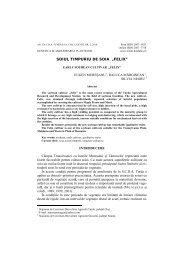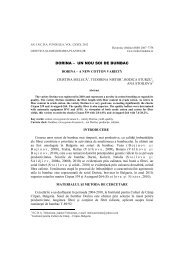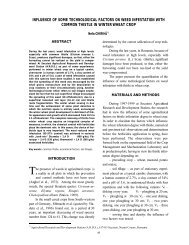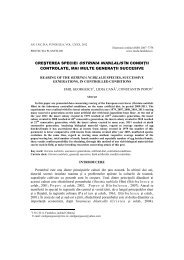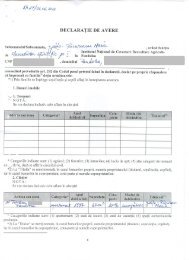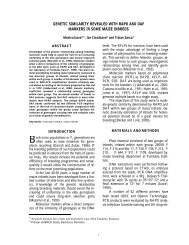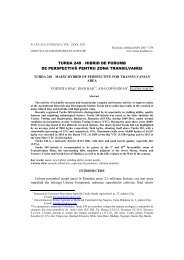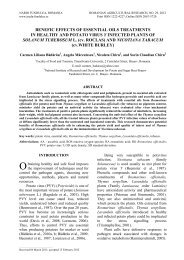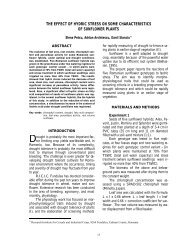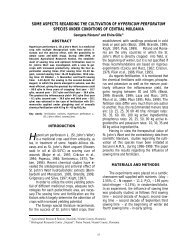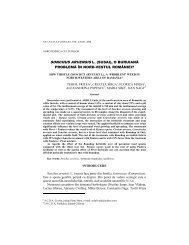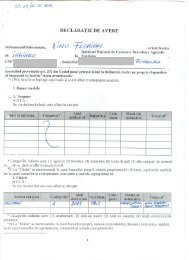FIFTY YEARS OF BREEDING IN FIELD CROPS, AT THE NATIONAL ...
FIFTY YEARS OF BREEDING IN FIELD CROPS, AT THE NATIONAL ...
FIFTY YEARS OF BREEDING IN FIELD CROPS, AT THE NATIONAL ...
You also want an ePaper? Increase the reach of your titles
YUMPU automatically turns print PDFs into web optimized ePapers that Google loves.
<strong>FIFTY</strong> <strong>YEARS</strong> <strong>OF</strong> <strong>BREED<strong>IN</strong>G</strong> <strong>IN</strong> <strong>FIELD</strong> <strong>CROPS</strong>, <strong>AT</strong> <strong>THE</strong> N<strong>AT</strong>IONAL<br />
AGRICULTURAL RESEARCH AND DEVELOPMENT <strong>IN</strong>STITUTE<br />
FUNDULEA, ROMANIA<br />
Marian Verzea 1<br />
ABSTRACT<br />
The National Agricultural Research and Development<br />
Institute (NARDI) Fundulea celebrates, in 2007, fifty<br />
years of research on field crops at Fundulea. The paper is<br />
a short presentation of the main results obtained in field<br />
crops breeding during this period. It summarizes the contribution<br />
of the institute to the genetic improvement of<br />
impo rtant crops, such as wheat, maize, sunflower, forrage<br />
crops etc. The Fundulea Institute had pioneering activity<br />
in breeding hybrid sunflower, releasing the first commercially<br />
grown hybrids in 1971. Many hybrids bred at Fundulea<br />
were registered and have been cultivated in countries<br />
like Italy, France, Spain, China etc. Semidwarf winter<br />
wheat varieties bred at Fu ndulea have been grown on<br />
half to two-thirds of Romania’s wheat acreage for the last<br />
30 years, and some of them are registered in Hungary,<br />
Canada, Turkey etc. Genetic progress in breeding triticale<br />
made this new crop a reality in Romanian agriculture.<br />
In maize Fundulea Institute contributed to the<br />
rapid replacement of local populations and openpollinated<br />
varieties by introduced double hybrids, and<br />
then to replacing those with better adapted single hybrids,<br />
obtained with adapted inbred lines. During 50 years<br />
of maize breeding, 82 hybrids with large diversity of traits<br />
were released. Semidwarf winter durum cultivars with<br />
suitable winterhardiness for Romania were released.<br />
Nineteen cultivars of six-row and two-row winter barley<br />
and eight early maturing rice vari eties were released. As<br />
result of over 40 year of breeding at Fundulea, 36 varieties<br />
of soybeans, beans and peas with improved adaptation<br />
were registered. In fodder crops, breeding work resulted<br />
in the release of 60 varieties, including 20 alfalfa cultivars,<br />
2 sainfoin, 2 field peas, 1 vetch and 35 grasses varieties<br />
(8 orchard grass, 6 Italian ryegrass, 4 hybrid ryegrass,<br />
2 perennial ryegrass, 3 tall fescue, 1 smooth brome, 5<br />
Sudan grass and 6 millet). In total 316 cultivars have<br />
been released by the institute, representing an important<br />
contribution to higher and more stable yields in field<br />
crops.<br />
Key words: breeding, field crops, cultivars, hybrids.<br />
T<br />
<strong>IN</strong>TRODUCTION<br />
he National Agricultural Research and Development<br />
Institute (NARDI) Fundulea celebrates,<br />
in 2007, fifty years of research on field<br />
crops at Fundulea. However, NARDI continues a<br />
longer tradition of agricultural research in Romania,<br />
being the main successor of the former Romanian<br />
Agronomical Research Institute (ICAR) in<br />
Bucharest, founded in 1927. During the 50 years<br />
of activity at Fundulea, the Institute changed the<br />
name several times, from „Research Institute for<br />
Maize Crop” in 1957, to „Research Institute for<br />
Cereals and Industrial Crops” in 1962, then to<br />
„Agricultural Research and Development Institute”<br />
in 2002 and to its present name in 2007. The<br />
activity however continued and developed without<br />
interruption.<br />
NARDI is the largest agricultural research institution<br />
in Romania, as it has the mission to provide<br />
to farmers scientifical results for the progress<br />
of several of the main agricultural crops (cereals,<br />
grain legumes, oil and fiber crops, forrage crops),<br />
which occupy most of agricultural area of Romania<br />
(91% in 2004) and have a large share of agricultural<br />
revenues (28.4% in 1999) (Verzea,<br />
2007).<br />
The main directions of NARDI Fundulea<br />
have been:<br />
- breeding varieties or hybrids adapted to<br />
the Romanian environment, and especially to the<br />
Southern plains of the country, in cereals (small<br />
grains, maize, sorghum), grain legumes, oil crops<br />
(sunflower, linseed), and forrage crops;<br />
- improving crop management practicies, including<br />
those for organic agriculture, adapted to<br />
the Romanian environment;<br />
- recommending integrated plant protection<br />
measures, based on pest biology and monitoring<br />
studies;<br />
- fundamental research on genetics, biotechnology,<br />
plant physiology, biochemistry etc. to support<br />
applied research on breeding and agronomy;<br />
- producing basic seed of own cultivars and<br />
providing seed to seed multiplying farmers;<br />
- extension of research results to the farmers.<br />
1 National Agricultural Research & Development Institute Fundulea, 915200 Fundulea, Calarasi County, Romania
2<br />
ROMANIAN AGRICULTURAL RESEARCH<br />
Number 24/2007<br />
This paper is a short presentation of the main<br />
results obtained in plant breeding at Fundulea so<br />
far.<br />
M<strong>AT</strong>ERIAL AND METHODS<br />
All breeding programs at Fundule a have<br />
been based on the use of a large genetic diversity,<br />
including local populations and cultivars (especially<br />
in maize), related species and genera (especially<br />
in sunflower and wheat), intensive germplasm<br />
exchanges with international breeding centers<br />
(CIMMYT, ICARDA etc.), germplasm<br />
banks and other breeding institutions. Large<br />
working collections are maintained and continuously<br />
improved, in each crop. Breeding lines selected<br />
in Institute’s breeding programs are continuously<br />
added to the working collection and are<br />
increasingly used as parents in crosses, based on<br />
principles of recurrent selection.<br />
Various recurrent selection methods in population<br />
breeding as initial material, and selection<br />
methods of inbreeds and hybrids have been used,<br />
especially in maize and sunflower, in order to increase<br />
the yielding capacity and its stability.<br />
A strong point in breeding at Fundulea has<br />
been the possibility to base selection on data collected<br />
in many cooperating research stations, situated<br />
in a large diversity of environments. This, together<br />
with the use of artificial tests for many of<br />
the important adaptation traits (winterhardiness,<br />
drought resistance, disease resistance etc.), and<br />
the recent use of molecular markers for specific<br />
traits, contributed to the adaptation of released<br />
cultivars to the targeted environment.<br />
Most breeding programs perform own<br />
small research projects on pre-breeding and genetics<br />
to enlarge and improve the knowledge of<br />
the genetic basis of physiological and quality traits<br />
of the biological material used in breeding.<br />
RESULTS AND DISCUSSION<br />
In wheat the five decades history of Fundulea<br />
work on improving the genetic basis of<br />
wheat production in Romania can be divided in<br />
four periods (Saulescu et al., 2007):<br />
† First period started in 1958, when it was<br />
realized that wheat breeding results in Romania<br />
lagged behind those obtained in other countries.<br />
The Fundulea Institute recommended the introduction<br />
of several foreign cultivars, which significantly<br />
over yielded the old local cultivars. At the<br />
same time breeding work began to increase adaptation<br />
to local conditions.<br />
† Second period (1971-1979) included the<br />
release of 9 standard-height cultivars with better<br />
adaptation to Romanian conditions, from Dacia,<br />
Excelsior and Favorit, released in 1971, to Fundulea<br />
29, which was grown on 40% of the wheat<br />
area in Romania and had outstanding results in the<br />
International Winter Wheat Performance Nursery<br />
in 1980 and 1981.<br />
† Third period (1984-1993), included the<br />
release of the first 6 semidwarf winter wheat cultivars,<br />
well adapted to the conditions of Southern<br />
Romania. Flamura 85, Fundulea 4 and Dropia<br />
have been particularly successful, being grown<br />
each on more than 20% of the wheat area.<br />
† Fourth period (1998-2006), is illustrated<br />
by the release of 8 new semidwarf cultivars, including<br />
Ardeal, Boema, Delabrad, Faur, Glosa<br />
and Gruia, now under multiplic ation, which<br />
brought further genetic progress and diversification.<br />
Genetic progress for yield was earlier estimated<br />
at about 50 kg/ha/year or about 1%/year.<br />
This was accompanied by an improvement in<br />
bread-making quality and in yield stability, due to<br />
improved lodging resistance, earliness, disease<br />
and drought resistance. From 1977 on, wheat<br />
cultivars released from Fundulea have been grown<br />
on more than half of the wheat acreage in Romania.<br />
Several cultivars created at Fundulea were<br />
registered and are grown in countries like Canada,<br />
Hungary, Turkey, Kyrgyz Republic and Bulgaria.<br />
In durum wheat, work started in 1967 resulted<br />
in the creation of semidwarf winter durum<br />
cultivars Topaz, Rodur, Pandur, Condurum and<br />
Grandur, which opens the possibility of durum<br />
production in South Romania.<br />
The introgression of new genes from wheat<br />
relatives and from international germplasm exchanges<br />
into the adapted semidwarf cultivars released<br />
so far, opens new prospects of progress in
MARIAN VERZEA: <strong>FIFTY</strong> <strong>YEARS</strong> <strong>OF</strong> <strong>BREED<strong>IN</strong>G</strong> <strong>IN</strong> <strong>FIELD</strong> <strong>CROPS</strong>,<br />
<strong>AT</strong> NARDI FUNDULEA, ROMANIA<br />
3<br />
the near future. Genetic progress has been accelerated<br />
in recent years, by routinely using the Zea<br />
system of producing doubled haploids from most<br />
interesting crosses (Giura et al., 2007).<br />
In triticale, from the start of the program<br />
(1971) to present, an original triticale germplasm<br />
adapted to the Romanian environment was created<br />
and 8 varieties were registered. Two triticale<br />
cultivars bred at Fundulea are registered in Hungary<br />
and USA.<br />
The genetic progress for yield estimated over<br />
a 22 years, period was 1.06% year - ¹, similar with<br />
the progress obtained in the most dynamic triticale<br />
breeding programs in the world. The yield improvement<br />
was based on improving the number of<br />
kernels per spikes, the weight of the kernels per<br />
spikes, test weight and on the reduction of the<br />
plant height (Ittu et al., 2007). Due to the genetic<br />
progress achieved by breeding, triticale is already<br />
grown on a significant area in Romania.<br />
In winter barley, as a result of the breeding<br />
program at Fundulea, 19 cultivars were released,<br />
14 out of them winter barley (Intensiv 1, Intensiv<br />
2, Miraj, Productiv, Precoce, Dana, Adi,<br />
Madalin, Orizont, Andrei, Compact, Regal, Liliana<br />
and Univers) and 5 winter two-rowed barley<br />
(Azuga, Victoria, Grivita, Laura and Andra). After<br />
the release of varieties Intensiv 1 and Intensiv 2,<br />
which brought a significant progress in winterhardiness,<br />
the release of Miraj in 1974, represented a<br />
milestone in improving lodging resistance and<br />
yielding ability. This variety was already grown on<br />
the whole barley area only five years after it release.<br />
Each successive release represented a step<br />
ahead in yielding ability, resistance to biotic and<br />
abiotic stress, technological quality and germoplasm<br />
diversity (Bude and Vasilescu, 2007).<br />
Beginning from 1992, the „bulbosum” system<br />
of obtaining doubled haploids has been used,<br />
to rapidly achieve genetic uniformity and to accelerate<br />
genetic progress.<br />
In rice breeding work started in 1961 at the<br />
Rice Experimental Center Chirnogi, belonging to<br />
the Fundulea Institute, aiming to release varieties<br />
with the main agronomic and adaptation traits useful<br />
to Romanian conditions, at the Northern limit<br />
of rice growing area. First varieties, from this program,<br />
Sidef and Ariana, were registered in 1975<br />
and 1984 respectively.<br />
Diversification of parents used in crossing, by<br />
using germplasm from various parts of the world<br />
(Asia, America, Africa and Australia) and selection<br />
in material obtained by induced mutations,<br />
allowed significant progress in adaptation and performance<br />
of the breeding material and the release<br />
of new rice varieties: Speranta (1994), Dunarea<br />
(1998), Elida (2001) and Zefir (2003), obtained<br />
by crossing followed by individual selection and<br />
Oltenita (1991) and Magic (2005) obtained by<br />
induced mutations. These varieties produce yields<br />
up to 8.0 t/ha and have different grain shapes and<br />
superior quality (Alionte et al., 2007).<br />
In maize, during the first period, the Fundulea<br />
Institute had a decisive contribution to the<br />
rapid replacement (in only 7 years) of local maize<br />
varieties and populations, which were dominant<br />
when the Institute was founded, with double<br />
crosses between foreign inbreds, identified as<br />
valuable under Romanian conditions, by extensive<br />
testing organized by the institute. This provided a<br />
31-43% yield increase in yield trials, reflected in a<br />
500 kg/ha (39%) increase of average maize yield<br />
of the country, from 1270 kg/ha during 1951-<br />
1955 to 1770 kg/ha during 1961-1965.<br />
The successive replacement of foreign double<br />
crosses with own formula double crosses and<br />
further on, with newly released, Romanian double<br />
crosses, better adapted to specific conditions of<br />
Romania and then, with more performant Romanian<br />
single and three-way crosses determined a<br />
genetic progress, during 1963-1985, of 105<br />
kg/ha/year. This contributed to the increase of<br />
country’s average yields to 4080 kg/ha during<br />
1981-1985.<br />
The genetic progress estimated during 1978-<br />
1996, was maintained at a high level (83<br />
kg/ha/year – 80% vs. previous period), although<br />
the same hybrid types were bred and new targets<br />
were added (Sarca et al., 2007).<br />
During 50 years of maize breeding, 82<br />
hybrids with large diversity of traits were released<br />
and registered, in accordance with farmer requirements<br />
and with modern breeding aims.
4<br />
ROMANIAN AGRICULTURAL RESEARCH<br />
Number 24/2007<br />
In sorghum, breeding work, started at Fundulea<br />
in 1960 and has resulted so far in the release<br />
of grain sorghum hybrids F.31 (in 1965),<br />
F.21 (in 1979), F.30 (in 1981), F.32 (in 1979).<br />
Promising high lysine grain hybrids F. 261 hld and<br />
F.380 hlp were also created.<br />
Remarkable results were obtained for yield<br />
without irrigation in hybrids F.32 (9270 kg/ha)<br />
and F.380-83 (8798 kg/ha), for crude protein<br />
yield in hybrids F.380-83 hlp (1179 kg/ha) and<br />
F.32 (1025 kg/ha), for lysine content in hybrids<br />
F.389-83 hlp (2.98 g/100 g protein) and F.261<br />
hld (2.82 g/100 g protein), for fat content in<br />
F.261 hld (4.9-6.1%), for starch content in F.32<br />
(74%), for vitamin B3 content in F.261 hld (1.20<br />
mg/100 g dry matter), for vitamin E content in<br />
F.32 (2.96 mg/100 g dry matter), and for vitamin<br />
PP content in F.261 hld (2.76 g/100 g dry matter)<br />
(Antohe, 2007).<br />
Forage sorghum - Sudan grass hybrids,<br />
for green fodder and silage, released so far include<br />
F.1104 (in 1971), Tutova (in 1992), Tinca<br />
(in 1996) and Tereza (in 2003). Tereza produced<br />
88.7 tons/ha green matter when harvested at preboot<br />
stage and 108.9 tons/ha at milk stage, or<br />
23.7 t/ha dry matter at pre-boot stage and 28.1<br />
t/ha at milk stage. The share of leaves and panicles<br />
from total plant dry matter was 56%, as<br />
compared with 49.2% in the check F.1104, and<br />
protein content was 18.7% at pre-boot stage and<br />
13.4% at milk stage. Twenty-eight days after harvesting<br />
the forage contained 31.1 mg HCN/100 g<br />
dry matter, making it suitable for feeding livestock<br />
at paddock or by grazing, fresh or 4-5 days after<br />
frost (Antohe, 2007).<br />
In sweet sorghum, breeding started at Fundulea<br />
in 1981 and resulted in the release of hybrids<br />
Rosa (in 1991), Doina (in 1996), Prut (in<br />
2000) and F.135 ST (in 2004) and of variety<br />
Carmen (in 1994). Remarkable results were obtained<br />
with the hybrid F.135-ST, which produced<br />
81-120 t/ha fresh biomass, 34.6-43.8 t/ha dry<br />
biomass, 5.4-8.7 t/ha total sugar, 5.4-9.7 t/ha<br />
grain yield and 5.5-7.5 t/ha lignocelluloses (Antohe,<br />
2007).<br />
In broom-sorghum, breeding started at<br />
Fundulea in 1978 and resulted in the release of<br />
varieties Siret (in 1996), Denisa (in 1998) and<br />
Donaris (in 2003). Denisa is noticeable for panicles<br />
yield (7.9 t/ha) and number of branches per<br />
panicle, while Siret had the highest average panicle<br />
length (64 cm) (Antohe, 2007).<br />
In grain legumes, as result of over 40 year<br />
of breeding at Fundulea, 36 varieties of soybeans,<br />
beans and peas were released and registered.<br />
In soybeans, with the release of varieties<br />
Flora and Violeta (in 1972), Precoce 90 (in<br />
1979), Tomis (in 1981), Danubiana (in 1983) and<br />
Atlas (in 1986) yielding ability increased from<br />
3000 kg/ha to over 5000 kg/ha, and protein content<br />
from 37% to 43.5%.<br />
Next released varieties: Lena and Stil (in<br />
1988), Victoria (in 1990), Columna (in 1995),<br />
Triumf (in 1996), Românesc 99 (in 1999) and<br />
Daciana (in 2006), continued the progress in<br />
yielding ability and stability.<br />
In field beans, the release of varieties F.332<br />
and F.416 (in 1965), Progres (in 1968), Orizont<br />
(in 1977), Premial (in 1978), Avans (in 1981),<br />
Aversa (in 1983), Astra (in 1991), Star (in 1989),<br />
Ami (in 1991), Diva (in 1995), Vera (in 1996),<br />
Delta (in 2003) and Lizica (in 2005) resulted in<br />
incresing yielding ability from 1300-2400 to<br />
2500-4000 kg/ha and in improving quality.<br />
In field peas from the variety F.53-54, registered<br />
in 1962 to the new aphyla type varieties<br />
Mona and Aurora, registered in 1999 and 2003<br />
respectively, there was a continuous improvement<br />
in yield and stress resistance.<br />
The accumulation of valuable genes into the<br />
current germplasm allows solving new challenges,<br />
especially those related to climatic changes<br />
(David, 2007).<br />
In sunflower, breeding results made the<br />
Fundulea Institute known worldwide. Concomitantly<br />
with classical selection work, resulting in the<br />
release in 196 of variety Record, which overyielded<br />
best Russian varieties by about 7% and<br />
had an oil content of 47-50%, research on producing<br />
hybrids between inbred lines was initiated.<br />
On this basis, in 1971 first hybrids, Romsun 52<br />
and Romsun 53, were released, with lines carrying<br />
male -sterility genes linked with marker genes,<br />
controlling anthocyanin presence in pla ntlets.<br />
These were the first hybrids produced commer-
MARIAN VERZEA: <strong>FIFTY</strong> <strong>YEARS</strong> <strong>OF</strong> <strong>BREED<strong>IN</strong>G</strong> <strong>IN</strong> <strong>FIELD</strong> <strong>CROPS</strong>,<br />
<strong>AT</strong> NARDI FUNDULEA, ROMANIA<br />
5<br />
cially and Romania became the first country to<br />
grow hybrid sunflower on a large scale.<br />
Later, new hybrids were released, based on<br />
the use of cytoplasmic male-sterility and restoration<br />
of pollen fertility, a system that is much more<br />
efficient for hybrid seed production.<br />
Genetic progress in the period 1965-1982<br />
was estimated at 64 kg/ha/year for yield and at<br />
0.3%/year for oil content. At the same time significant<br />
progress has been achieved for disease<br />
resistance, based on the identification of efficient<br />
resistance genes for mildew, for the parasite Orobanche<br />
cumana etc. Progress was also achieved<br />
in improving pollen selfcompatibility and hybrids<br />
with 60-70% selfcompatibility were obtained.<br />
Since 1971, thirty three hybrids have been<br />
released and widely grown, not only in Romania,<br />
but also in countries like France, Spain, Turkey,<br />
Greece, Italy and China.<br />
In the last years, a special emphasishas been<br />
put on breeding for high oleic acid content and for<br />
resistance to herbicides (imidazolinone and sulfonylurea).<br />
The first „high oleic” hybrids are now in<br />
the comparative trials, and first sunflower hybrids<br />
resistant to herbicides will be obtained in the next<br />
two years (Pacureanu et al., 2007).<br />
In linseed and flax, breeding work at Fundulea<br />
continued the research, initiated at the Romanian<br />
Agronomical Research Institute (I.C.A.R.)<br />
in 1938. Sixty linseed and flax cultivars, adapted<br />
to the Romanian environment, have been released<br />
so far. They show a significant genetic progress in<br />
Fusarium resistance, oil or fiber content, lodging<br />
resistance and yield. Several yellow seed cultivars<br />
wih improved disease resistance and oil content<br />
over 45% have also been released. Beginning<br />
from 1957, the whole linseed acreage in Romania<br />
has been cultivated with Romanian cultivars, and<br />
some of them have also been registered in other<br />
countries, such as Germany and U.K. (Doucet<br />
and Doucet, 2007).<br />
In fodder crops, breeding work, initiated in<br />
1949 at the former Romanian Agronomical Research<br />
Institute (ICAR), and transfered in 1961 to<br />
RICIC Fundulea, resulted in the release of 60<br />
varieties, during the last 50 years. They include 20<br />
alfalfa cultivars, 2 sainfoin, 2 field peas, 1 vetch<br />
and 35 grasses varieties (8 orchard grass, 6 Italian<br />
ryegrass, 4 hybrid ryegrass, 2 perennial ryegrass,<br />
3 tall fescue, 1 smooth brome, 5 Sudan<br />
grass and 6 millet).<br />
The most important results were obtained in<br />
alfalfa breeding, the first released cultivar being<br />
Fundulea 652 registered in 1962. After that, in the<br />
70s, the extensive cultivars Luxin and Lutetia were<br />
released. The cultivar Gloria (1982) represented a<br />
new stage, by utilization of a male-sterility source,<br />
which allowed a high level of heterosis for fodder<br />
yield and resistance to diseases.<br />
The release of cultivars Selena, Topaz, Magnat,<br />
and Sigma was considered as an important<br />
progress in alfalfa breeding, followed by other 10<br />
cultivars with high nutritive value of fodder registered<br />
in the last ten years (Schitea and Varga,<br />
2007).<br />
In grasses, besides the release of synthetic<br />
cultivars consisting of clones, the<br />
synthetic cultivars of hybrid ryegrass were<br />
considered an important achievement.<br />
They were obtained from progenies selected<br />
from interspecific hybrids Italian ryegrass x perennial<br />
ryegrass (Lolium multiflorum x Lolium perenne).<br />
CONCLUSIONS<br />
Fifty years of breeding at Fundulea, using a<br />
large diversity of germplasm, including local populations<br />
and cultivars and related species, and testing<br />
in many diverse locations, resulted in a significant<br />
genetic progress and in release of many successful<br />
cultivars in field crops.<br />
These cultivars, along with numerous valuable<br />
breeding lines and populations, represent a<br />
solid basis for further progress in breeding for<br />
adaptability, yield and quality and in meeting new<br />
challenges, both locally and globally.<br />
REFERENCES<br />
Alionte, Gh., Iorga, Daniela, Alionte, Eliana, 2007. Rezultate<br />
în ameliorarea orezului la Fundulea. Analele <strong>IN</strong>CDA Fundulea,<br />
LXXV: 95-98.<br />
Antohe, I., 2007. Realizari în ameliorarea sorgului la Fundulea.<br />
An. <strong>IN</strong>CDA Fundulea, LXXV: 137-157.
6<br />
ROMANIAN AGRICULTURAL RESEARCH<br />
Number 24/2007<br />
Bude, A., Vasilescu, Liliana, 2007. Rezultate obtinute în ameliorarea<br />
orzului de toamna la Fundulea. Analele <strong>IN</strong>CDA<br />
Fundulea, LXXV: 83-93.<br />
David, Ionica, 2007. Realizari în ameliorarea leguminoaselor<br />
pentru boabe la Fundulea. Analele <strong>IN</strong>CDA Fundulea,<br />
LXXV: 159-171.<br />
Doucet, Ilaria, Doucet, M., 2007. Rezultatele cercetarilor de<br />
ameliorare la inul de ulei si inul de fibre în România.<br />
Analele <strong>IN</strong>CDA Fundulea, LXXV: 195-202.<br />
Giura, A., Mihailescu, Alexandrina, Verzea, M., Ittu, Gh.,<br />
2007. Cercetari de genetica efectuate la Fundulea. Analele<br />
<strong>IN</strong>CDA Fundulea, LXXV: 25-42.<br />
Ittu, Gh., Saulescu, N.N.. Ittu, M., Mustatea, P., 2007. Realizari<br />
în amelorarea la triticale (xTriticosecale Witt.) la<br />
Fundulea. Analele <strong>IN</strong>CDA Fundulea, LXXV: 73-82.<br />
Pacureanu, Maria, Vrânceanu, A.V., Stanciu, D., 2007. Cincizeci<br />
de ani de activitate în ameliorarea florii-soarelui la<br />
Fundulea. Analele <strong>IN</strong>CDA Fundulea, LXXV: 173-194.<br />
Sarca T., Cosmin, O., Antohe, I., 2007. Cercetari si realizari în<br />
ameliorarea porumbului la Fundulea. Analele <strong>IN</strong>CDA<br />
Fundulea, LXXV: 99-135.<br />
Saulescu, N.N., Ittu, Gh., Ittu, M., Mustatea, P., 2007. Cinci<br />
decenii de ameliorare a grâului la Fundulea. Analele<br />
<strong>IN</strong>CDA Fundulea, LXXV: 55-72.<br />
Schitea, Maria, Varga, P., 2007. Realizari în ameliorarea plantelor<br />
furajere la Fundulea. Analele <strong>IN</strong>CDA Fundulea,<br />
LXXV: 203-227.<br />
Verzea, M., 2007. Realizari si perspective în domeniul cerealelor,<br />
plantelor tehnice si furajere. Analele <strong>IN</strong>CDA<br />
Fundulea, XXV: 11-24



